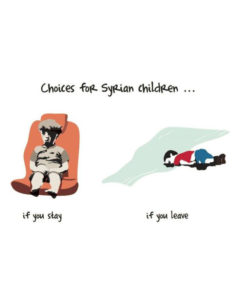New report outlines plight of child refugees
Just days after the first anniversary of the death of Alan Kurdi – the little refugee boy whose body washed up on a beach in Turkey causing a worldwide outcry – UNICEF has released a new report highlighting the plight of displaced children.
The report, titled Uprooted: The growing crisis for refugee and migrant children and one of the first to study the specific effects of the refugee crisis on children, found that 50 million children have migrated across borders or been forcibly displaced and there were an estimated 11 million child refugees and asylum seekers in 2015 – more than double the estimate from 2005.
The report said nearly half of them are from Syria and Afghanistan alone.
 “This is a growing crisis; it’s a children’s crisis. Huge numbers of these refugees — half of them — are children,” UNICEF Deputy Executive Director Justin Forsyth told a press conference this week.
“This is a growing crisis; it’s a children’s crisis. Huge numbers of these refugees — half of them — are children,” UNICEF Deputy Executive Director Justin Forsyth told a press conference this week.
The report said 28 million children had fled violence or insecurity and almost one in three children living outside their birth countries are refugees.
Children are uniquely vulnerable to the worst parts of the refugee crisis, the report said.
Because children are often travelling alone or with limited resources, they are at heightened risk of exploitation, including trafficking, sexual exploitation, and enslaved labour.
Mr Forsyth said that on one route through the Mediterranean, nine out of 10 children traveling were alone.
“The stories they tell are horrific before they ever get onto those boats,” he said.
The report revealed that children represent a disproportionate and growing proportion of those who have sought refuge outside their countries of birth: they make up about a third of the global population but about half of all refugees.
It said more and more children were crossing borders on their own. In 2015, over 100,000 unaccompanied minors applied for asylum in 78 countries – triple the number in 2014. Unaccompanied children are among those at the highest risk of exploitation and abuse, including by smugglers and traffickers.
About 20 million other international child migrants have left their homes for a variety of reasons including extreme poverty or gang violence. the report said.
Many were at risk of abuse and detention because they have no documentation, they have uncertain legal status, and there is no systematic tracking and monitoring of their well-being.
According to the report, Turkey hosts the largest total number of recent refugees, and very likely the largest number of child refugees in the world.
Relative to its population, Lebanon hosts the largest number of refugees by an overwhelming margin: Roughly one in five people in Lebanon is a refugee.
By comparison, there is roughly one refugee for every 530 people in the United Kingdom; and one for every 1,200 in the United States.
It says that the Democratic Republic of the Congo, Ethiopia, and Pakistan shoulder the biggest burden and highest concentration of refugees when you look at refugee-host countries by per-capita income levels.
The report argues that where there are safe and legal routes, migration can offer opportunities for both the children who migrate and the communities they join.
It says analyses of the impact of migration in high-income countries found that migrants contributed more in taxes and social payments than they received; filled both high- and low-skilled gaps in the labour market; and contributed to economic growth and innovation in hosting countries.
But, it says children who have left or are forcibly displaced from their homes often lose out on the potential benefits of migration, such as education – a major driving factor for many children and families who choose to migrate.
A refugee child is five times more likely to be out of school than a non-refugee child. When they are able to attend school at all, it is the place migrant and refugee children are most likely to encounter discrimination – including unfair treatment and bullying.
Outside the classroom, legal barriers prevent refugee and migrant children from receiving services on an equal basis with children who are native to a country. In the worst cases, xenophobia can escalate to direct attacks. In Germany alone, authorities tracked 850 attacks against refugee shelters in 2015.
The report outlines six specific actions that would protect and help displaced, refugee and migrant children:
• Protecting child refugees and migrants, particularly unaccompanied children, from exploitation and violence
• Ending the detention of children seeking refugee status or migrating by introducing a range of practical alternatives
• Keeping families together as the best way to protect children and give children legal status
• Keeping all refugee and migrant children learning and giving them access to health and other quality services
• Pressing for action on the underlying causes of large-scale movements of refugees and migrants
• Promoting measures to combat xenophobia, discrimination and marginalisation
Laurie Nowell
AMES Australia Senior Journalist












